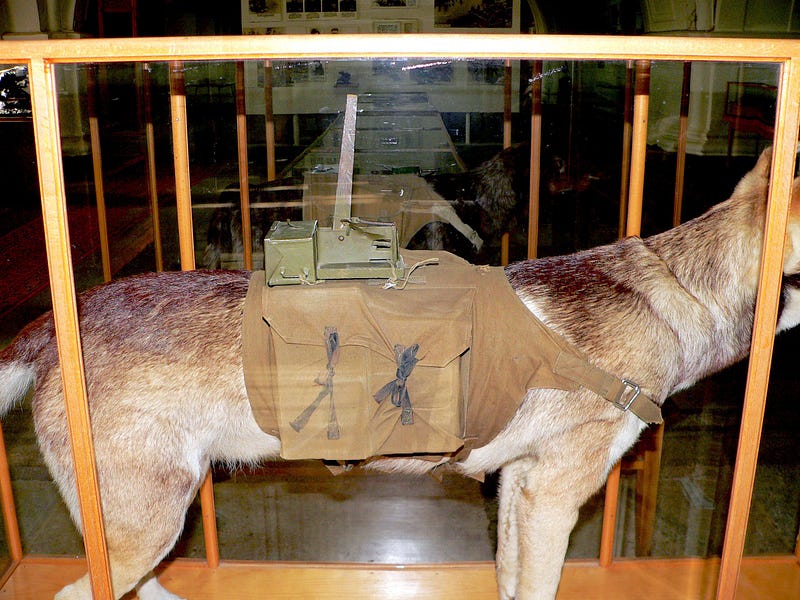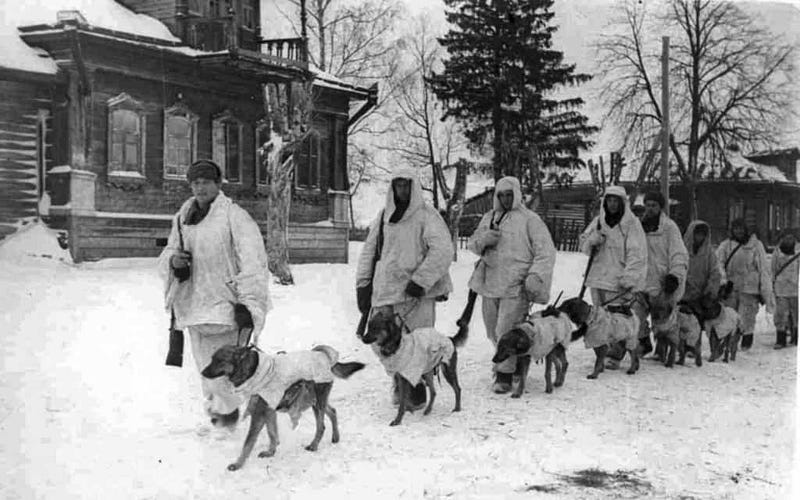 he Eastern Front of the Second World War saw some of the most brutal fighting of the whole war. The Soviet Union was desperate to protect their motherland while the well-oiled Nazi war machine pushed indiscriminately into the heart of the country. This desperation bred new tactics within the Soviet army, with new types of weapons being developed as a result.
he Eastern Front of the Second World War saw some of the most brutal fighting of the whole war. The Soviet Union was desperate to protect their motherland while the well-oiled Nazi war machine pushed indiscriminately into the heart of the country. This desperation bred new tactics within the Soviet army, with new types of weapons being developed as a result.
The goal of the Red Army was to use their defenders’ advantage as well as their ability to mass manufacture cheap equipment to push back the better-equipped German troops. To counteract one of the German’s biggest advantages, their tanks, the Soviets developed the Anti-Tank Dog.
Before the genesis
After the Russian Civil War and the victory of the Soviets against the Whites, the Red Army had to reform and readapt to the ever-evolving combat of the early 20th century. Thus in 1924, the Revolutionary Military Council of the Union of Soviet Socialist Republics approved the introduction of dogs as military equipment within the Red Army.
The plan was to use the dogs for a range of purposes such as first aid, tracking mines and people, rapid communication, assisting in combat, transporting small amounts of supplies, dragging injured soldiers on sleds, and what we’re going to be focusing on today, the destruction of enemy targets.

The newly formed Red Army lacked any kind of personnel to actually train the dogs to perform these tasks, so a campaign was started where anyone with dog training experiences, such as circus performers and hunters, were recruited into the Red Army.
Training took place at the newly founded training center in the Moscow region, where German Shepherds were the main target of the program due to their ease of training.
The Blitzkrieg problem
The Red Army lacked any real response to the newly developing military tactics of using a mainly tank-based force to break the enemy line. A response would come in the form of the famous T-34, but infantry lacked a consistent and effective way to combat this mainly mechanical force. For this, the Revolutionary Military Council would come up with an idea.
As stated before, one of the approved uses of the dogs within the Red Army was “the destruction of enemy targets.” With tanks becoming such a problem for the Soviets, a mine vest was developed for dogs, and anti-tank dog units were officially included in the Workers’ and Peasants’ Red Army.
Multiple prototypes of this mine vests were trialed, with the first prototypes being detachable. The initial plan was for the dogs to run under the tanks, bite a release mechanism that left the bomb under the tank and then return to the trainer. The bomb would then be detonated through a timer or remote detonator. A group of dogs practiced this for six months, but the reports show that no dogs could perform the task consistently thus, a more extreme approach was taken to training.

Amendments were made to the training, making it much simpler. The dogs were only taught to run under the tank. A new mine design was created which would detonate as soon as the dog made it under an enemy tank, thus making the training of a return journey unnecessary.
Each dog was fitted with an 11-kilogram mine carried in two pouches which could be adjusted depending on the dog. The mine had a safety pin that had to be removed before the dog was deployed, something that would become a problem when this concept was put into practice.
Deployment
When this brutal plan was put into practice, it did not pan out as expected. The first group of anti-tank dogs arrived at the frontline around mid-1941. The group was made out of around 30 dogs and 40 trainers. The initial deployment highlighted some major problems with the program.

In order to save resources, the dogs had been trained on tanks that stood still and didn’t use their guns. When the dogs were deployed on the front lines, this created a problem as they refused to run under the tanks due to them not being used to the sound of gunfire. The small minority of dogs who did try to ‘perform their duty’ would be too scared to go under the enemy tank and would get shot by the machine gunner as a result.
Another side effect of the dogs not being used to the gunfire of the front line was that they would run back to the trenches with the live explosive still attached to them, leading to the charge exploding and killing friendly soldiers. This meant that many of the dogs who tried to return to their trainers had to be shot, leaving many of the trainers unwilling to continue with the program criticizing it for its brutality, which led to many of these trainers being sent to a Gulag.

The final nail in the coffin for the program came about when the dogs were deployed on a field where both Soviet and German tanks were present. Due to being trained with Soviet tanks, they gravitated to the familiar-looking and smelling Soviet tanks instead of the unfamiliar German tanks leading to more friendly fire incidents as the dogs dove under the friendly Soviet tanks detonating their charge.
After 1942 the use of anti-tank dogs by the Red Army decreased as new and less inhumane roles were found for the dogs, although training for this brutal job would continue until 1966, when the program officially ended with limited success on the battlefield.
By any means necessary
This program exemplifies the desperation of the Great Patriotic War (the Soviet name for the Second World War) of the Soviet Union. Being pushed back to Moscow, the Red Army sought any means of gaining an advantage over the enemy, meaning that nearly no tactic was out of the question.
There exist other examples of the Soviets using unconventional or even illegal tactics during the war, such as explosive sniper bullets, but none were as brutal to animals as this program.
War brings out the worst in many people, and in such desperation, it is not surprising that more unconventional and brutal tactics developed. Thankfully, in the end, the program proved ineffective, and thus a limited number of dogs were actually deployed with this purpose, and even fewer were killed, although the brutal concept will forever be remembered.

Student of Philosophy, Politics and Economics. History fanatic. Contact: aneculaeseicg@gmail.com





